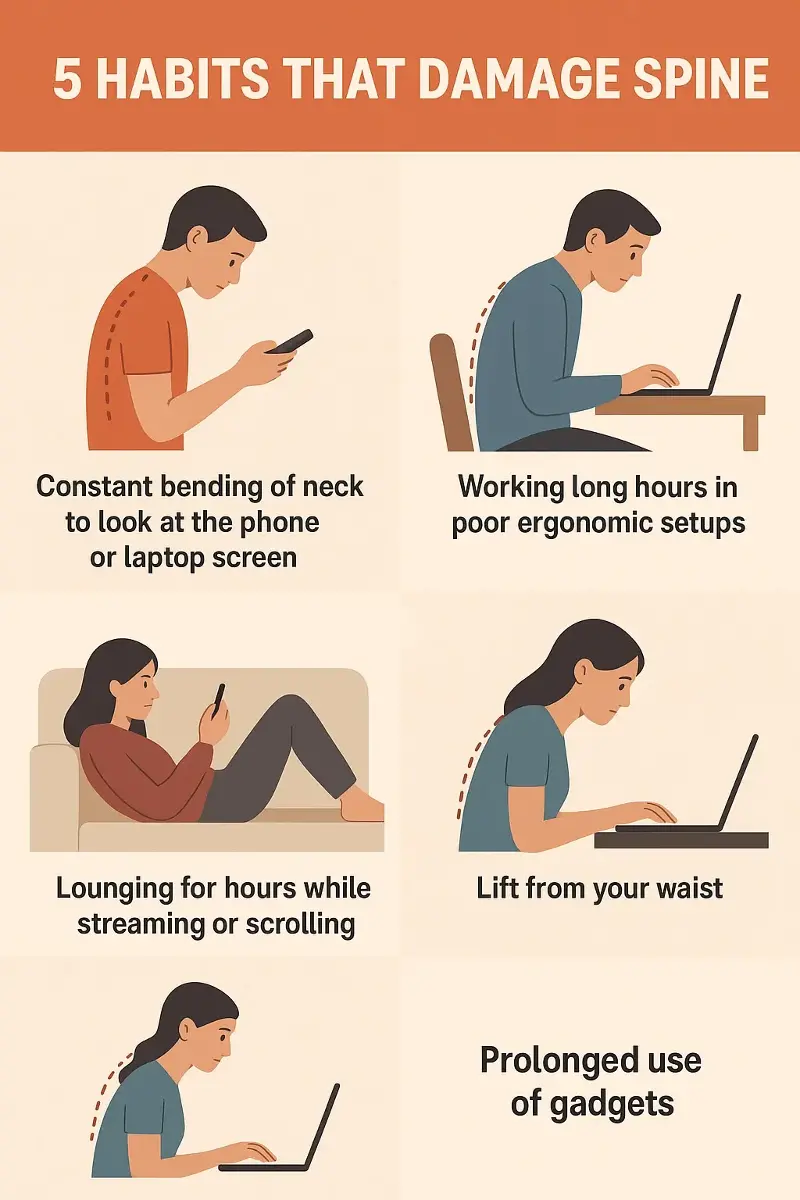
The spine is very crucial for the body's movement, in all forms, big and small. But with the rise of a sedentary lifestyle, spine health is in danger. In fact, as per the European Pain Federation, spinal pain remains the top cause of disability worldwide. It hampers movement, reduces flexibility, and over time paves the way to chronic pain, fatigue, and long-term spinal complications.
Interventional spine and pain physician Dr Sidharth Verma, clinical lead at Nivaan Interventional Pain and Regenerative Medicine clinic, shared with HT Lifestyle that taking care of spine health is essential. He warned about an epidemic. “An ‘invisible’ epidemic of back and neck pain affecting people in their 20s as much as those in their 50s,” he cautioned.
A Lancet study from November 2023 shed light on the serious burden spinal cord injury is, as it not only causes long-term disability but also early death. If spine health is weakened, one is at risk of spinal cord injuries.
Among the many spine problems, back pain continues to be the most common. World Health Organisation estimated that approximately 619 million people live with lower back pain. It is also the leading cause of disability. The numbers are projected to rise in the near future. A study published in The Lancet Rheumatology found that by 2050, that number is expected to reach 843 million.
But all hope is not lost. Dr Verma reassures that healthy habits, such as correct posture and better ergonomic setups help to protect spinal health. “If we treat the spine with consistency, it is remarkably adaptive. Routine corrections in how we sit, stand or walk can prevent decades of unwanted discomfort," Dr Verma said.
Further, new-age postures, especially those developed from constant screen use, have started to put unprecedented strain on the spine, causing problems, as the doctor noted, ‘not seen a decade ago.’
This is why one should rectify their spine-damaging habits. Since the spine is adaptive, early modification prevents major health risks.
Dr Verma suggested 5 such unhealthy habits and how you can fix it:

1. Constant bending of neck to look at the phone or laptop screen
Why it’s harmful:
- For every inch your head tilts forward, the pressure on your cervical spine doubles, leading to muscle strain, stiffness, and even disc compression.
- This is now one of the main reasons behind neck and upper-back pain in young adults.
How to fix it:
- The screen should be at the eye level, so bring the screen at the appropriate level than to tilt your head to the direction of the screen.
- The phone should be held at eye-level and a 30 min ‘neck break’ can strengthen upper back muscles with exercises like chin-tuck and shoulder-blade retraction.
2. Working long hours in poor ergonomic setups
Why it’s harmful:
- Slouching on couches, beds or dining tables overstretches spinal ligaments and weakens core, increasing the risk of postural fatigue or even chronic lower back pain.
How to fix it:
- Ensure that the natural curve of your spine is supported by your chair.
- In order to reset your posture, keep your feet flat, walk every 40 minutes, get the screen at eye level, or even stretch for 2 minutes.
3. Lounging for hours while streaming or scrolling
Why it’s harmful:
- Weakened muscles and a rounded spine are all we get from a sunken couch.
- Over time, fatigue and stiffness kick in with this posture, locking your thoracic and lumbar regions into misalignment.
How to fix it:
- Sit with a firm cushion behind your lower back to prevent leaning backwards excessively.
- Even during a rest period, movement is medicine.
- Avoid long sedentary stretches to avoid muscle tightening.
4. Lift from your waist
Why it’s harmful:
- A rounded lower back shifts the entire weight of the object to your lumbar discs, risking injury or a slipped disc.
How to fix it:
- Keep the load close to your body, bend your knees, not your spine, engage your core, and rise using your leg muscles.
5. Prolonged use of gadgets
Why it’s harmful:
- The added weight of excessive use of VR/AR headsets, gaming gear, or even peering down at smartwatches on your head and neck muscles, straining the cervical spine, has created new-age posture problems not seen a decade ago.
How to fix it:
- Choose lightweight, well-balanced wearables, and take frequent “tech-off” breaks backed by ergonomics.
Note to readers: This article is for informational purposes only and not a substitute for professional medical advice. Always seek the advice of your doctor with any questions about a medical condition.
